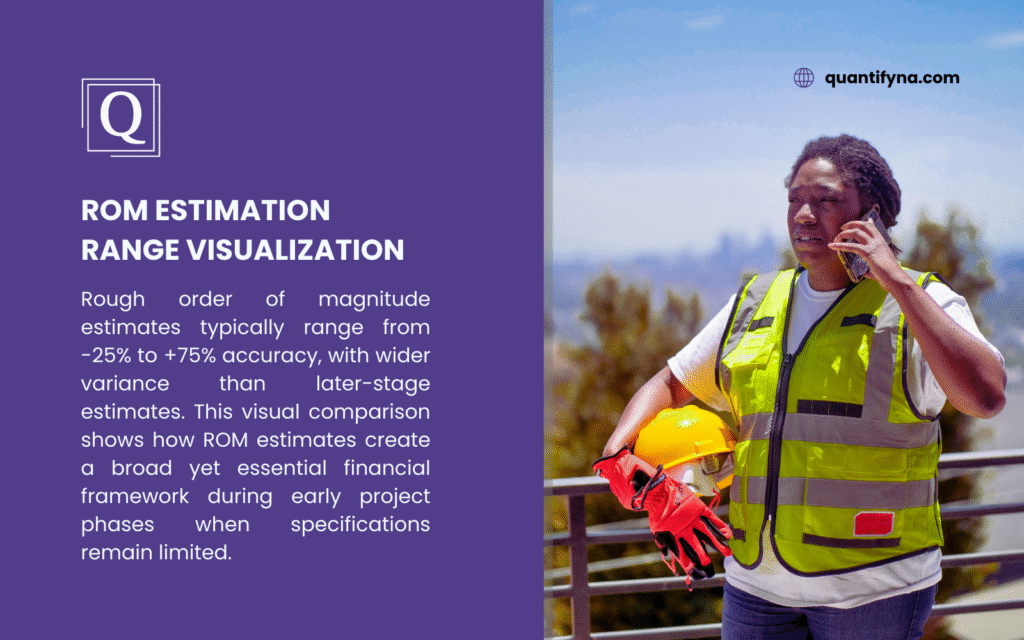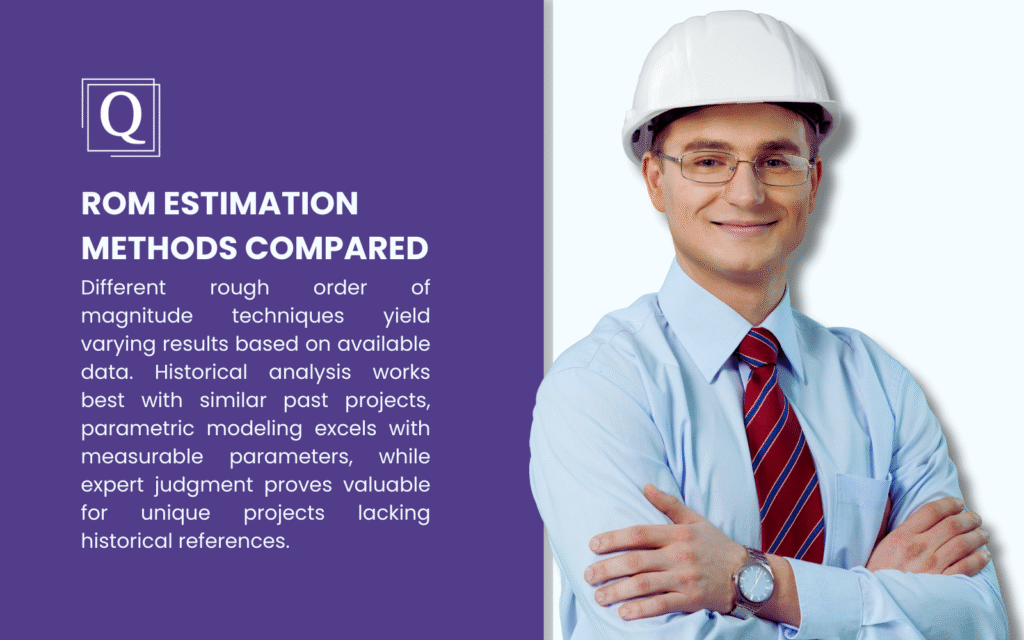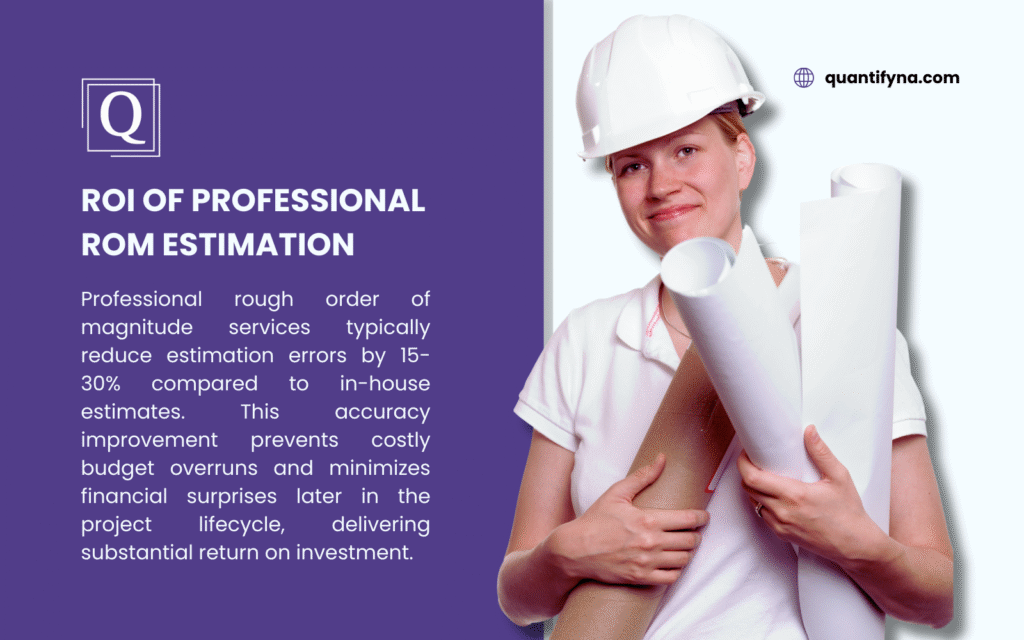Article Summary
- Definition and purpose of rough order of magnitude in construction estimation
- Key differences between rough order of magnitude and other estimation types
- Methods for creating accurate rough order of magnitude estimates
- Common challenges and solutions when developing rough order of magnitude estimates
- Benefits of professional rough order of magnitude services for contractors
- Best practices for implementing rough order of magnitude in your estimation workflow
In the construction industry, proper budgeting starts with accurate preliminary estimates. A rough order of magnitude serves as the vital first step in project planning, offering stakeholders an initial financial framework before detailed specifications become available. This critical early estimation enables feasibility assessments and fundamental decision-making that shapes project scope, timeline, and resource allocation.
What Is a Rough Order of Magnitude?
A rough order of magnitude (ROM) estimate represents an initial projection of project costs based on limited available information. This preliminary assessment establishes cost boundaries during early project phases when detailed specifications remain undefined. Construction professionals typically develop rough order of magnitude estimates with accuracy ranges of -25% to +75%, reflecting the inherent uncertainty at project inception.
The rough order of magnitude functions as a crucial planning tool that allows stakeholders to:
- Assess project viability before significant resource commitment
- Establish preliminary budgets for capital planning
- Compare potential projects for strategic prioritization
- Create baseline measurements for future detailed estimates

Unlike precise quotes provided during later project stages, a rough order of magnitude aims to deliver reasonable cost parameters that help determine whether to proceed with further planning or to adjust project scope to align with financial constraints.
The Role of Rough Order of Magnitude in Construction Estimation
Within the construction estimation hierarchy, the rough order of magnitude occupies a foundational position. The table below illustrates how ROM estimates compare to other estimation types throughout a project lifecycle:
| Estimate Type | Project Phase | Typical Accuracy | Required Information | Purpose |
| Rough Order of Magnitude | Conceptual | -25% to +75% | Project concept, general scope, location | Initial feasibility assessment |
| Budget Estimate | Preliminary Design | -15% to +30% | Basic designs, primary materials | Funding approval, resource allocation |
| Definitive Estimate | Detailed Design | -5% to +15% | Complete designs, specifications | Contractor bidding, precise budgeting |
| Control Estimate | Pre-Construction | -3% to +5% | Final designs, vendor quotes | Contract execution, performance baseline |
Construction professionals must recognize that each estimate type builds upon the previous one. The rough order of magnitude creates the foundation that evolves into more detailed assessments as project specifications develop. For commercial flooring, drywall, ceiling, and painting projects, these early estimates prove particularly valuable when contractors must quickly evaluate potential opportunities.
Methods for Creating Accurate Rough Order of Magnitude Estimates
Several approaches exist for developing effective rough order of magnitude estimates in construction projects. The selection of an appropriate method depends on available information, project complexity, and required accuracy.
Historical Data Analysis
Previous similar projects offer valuable reference points for developing rough order of magnitude estimates. By examining historical cost records and adjusting for variables like location, inflation, and scope differences, estimators can establish reasonable cost parameters for new projects.
For example, when creating a rough order of magnitude for a commercial flooring project, flooring estimating specialists may reference past projects with similar square footage, material types, and installation complexities to establish preliminary cost ranges.
Parametric Modeling
Parametric estimating uses mathematical relationships between project characteristics and costs to generate rough order of magnitude figures. This approach relies on key metrics such as:
- Square footage costs for various construction types
- Linear footage prices for specialized installations
- Unit costs for standard components
Parametric estimating proves especially effective for rough order of magnitude development when project details remain limited but basic parameters like size, location, and purpose have been established.
Expert Judgment
Experienced professionals bring invaluable insights to rough order of magnitude estimation. Their knowledge of market conditions, material costs, labor requirements, and risk factors enables the creation of reasonable cost projections even with minimal project information.
Companies like Quantify North America leverage decades of industry expertise to deliver accurate rough order of magnitude estimates across multiple trades, including drywall estimating and painting estimating.
Rough Order of Magnitude vs. Definitive Estimate
While both rough order of magnitude and definitive estimates project project costs, significant differences exist between these estimation approaches. Understanding these distinctions helps stakeholders select the appropriate estimation method based on project phase and available information.
| Characteristic | Rough Order of Magnitude | Definitive Estimate |
| Timing | Early conceptual phase | Late design phase |
| Accuracy Range | -25% to +75% | -5% to +15% |
| Information Required | Basic concept, location, general scope | Complete designs, specifications, vendor quotes |
| Development Time | Hours to days | Days to weeks |
| Purpose | Feasibility assessment, initial budgeting | Bidding, contract execution, detailed budgeting |
| Cost | Low to moderate | Moderate to high |
| Risk Level | High | Low |
The transition from rough order of magnitude to definitive estimate represents the natural evolution of the estimation process. As project details become increasingly defined, estimation accuracy improves accordingly. However, both estimation types serve essential functions within their respective project phases.

Common Challenges in Rough Order of Magnitude Development
Creating accurate rough order of magnitude estimates presents several challenges that construction professionals must address:
Limited Information
The defining characteristic of rough order of magnitude estimation—limited project details—also presents its greatest challenge. Estimators must make reasonable projections based on minimal specifications, requiring both technical expertise and experience-based judgment.
Market Volatility
Material price fluctuations, labor market changes, and economic shifts can significantly impact construction costs. Rough order of magnitude estimates must account for potential market volatility, especially for projects with extended timelines.
Scope Uncertainty
Without detailed specifications, project scope remains subject to interpretation. Estimators must clearly document assumptions and exclusions when developing rough order of magnitude figures to establish appropriate expectations.
Regional Variations
Construction costs vary significantly by location due to differences in labor rates, material availability, regulatory requirements, and environmental factors. Accurate rough order of magnitude estimates must incorporate these regional variations, particularly for contractors operating across multiple markets.
Best Practices for Effective Rough Order of Magnitude Estimation
Construction professionals can improve rough order of magnitude accuracy by implementing several proven strategies:
Document All Assumptions
Clear documentation of all assumptions, exclusions, and limitations provides essential context for rough order of magnitude figures. This transparency helps stakeholders understand the estimate’s basis and potential variation factors.
Incorporate Contingency Factors
The inherent uncertainty in rough order of magnitude estimation necessitates appropriate contingency allocation. The contingency percentage should reflect the project’s complexity, information availability, and risk factors.
Utilize Technology Solutions
Modern estimation software enhances rough order of magnitude accuracy through access to current cost databases, historical project information, and specialized calculation tools. Technology solutions also facilitate faster estimate development, allowing for rapid project feasibility assessments.
Apply Multiple Estimation Methods
Using several estimation approaches for the same project helps validate rough order of magnitude figures. When different methods produce similar results, estimators can have greater confidence in their projections. Conversely, significant variations indicate areas requiring further investigation.
Regular Market Research
Staying current with material prices, labor rates, and industry trends enables more accurate rough order of magnitude development. Regular market research helps estimators adjust historical data appropriately to reflect current conditions.

Benefits of Professional Rough Order of Magnitude Services
For many contractors, partnering with specialized estimation services for rough order of magnitude development offers significant advantages:
Enhanced Accuracy
Professional estimating services maintain extensive cost databases, employ advanced technology solutions, and utilize specialized expertise to produce more accurate rough order of magnitude figures. This improved accuracy supports better decision-making during early project phases.
Resource Optimization
Outsourcing construction estimating allows contractors to access specialized expertise without maintaining full-time estimating staff. This approach proves particularly valuable during peak periods when internal resources face capacity constraints.
Faster Turnaround
Dedicated estimating services can produce rough order of magnitude figures quickly, enabling contractors to evaluate more opportunities and respond faster to client inquiries. This efficiency creates competitive advantages in time-sensitive situations.
Multi-Trade Expertise
Professional services like Quantify North America offer rough order of magnitude estimates across multiple trades, including flooring, drywall, and painting. This comprehensive approach enables integrated estimation across project components.
Integrating Rough Order of Magnitude into Your Estimation Workflow
Construction professionals can maximize rough order of magnitude value by properly integrating this estimation type into their overall workflow:
Establish Clear Processes
Defined procedures for rough order of magnitude development ensure consistency across projects. These processes should specify when ROM estimates occur, what information must be available, which methods to use, and how to document results.
Create Estimation Templates
Standardized templates streamline rough order of magnitude development and improve consistency. These templates should include sections for assumptions, exclusions, contingencies, and confidence levels to provide appropriate context for the figures.
Build Historical Reference Libraries
Maintaining records of previous rough order of magnitude estimates alongside actual project costs creates valuable reference data for future estimation. This historical information becomes increasingly valuable as the database expands.
Implement Progressive Elaboration
The estimation process should follow a structured progression from rough order of magnitude through increasingly detailed estimates as project information develops. Each estimation stage builds upon previous work rather than starting anew.
Key Takeaways
- Rough order of magnitude estimates provide essential early cost projections for construction projects
- ROM accuracy typically ranges from -25% to +75% based on limited available information
- Multiple methods exist for rough order of magnitude development, including historical analysis, parametric modeling, and expert judgment
- Clear documentation of assumptions and appropriate contingency factors enhance rough order of magnitude effectiveness
- Professional estimating services offer specialized expertise that improves rough order of magnitude accuracy

Experience Expert Rough Order of Magnitude Estimates
Need reliable rough order of magnitude estimates for your construction projects? Quantify North America provides specialized estimating services for commercial flooring, drywall, ceiling, and painting projects. Our experienced team delivers accurate preliminary estimates that help you evaluate opportunities quickly and make informed decisions.Contact Quantify North America today to discuss how our estimating expertise can support your project success from concept through completion.




